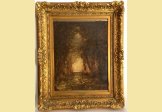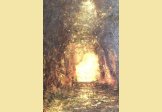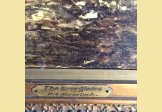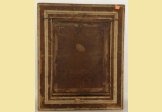The Everglades
| Artist | : | Ralph Albert Blakelock |
| Medium | : | Oil |
| Size unframed | : | 12"/14.5" |
| Size framed | : | N/A |
| Signature Info | : | Hand Signed - By the artist |
| Frame Info | : | Yes |
| Condition | : | Very Good |
| Year | : | Unknown |
Description
Ralph Albert Blakelock (1847-1919 - USA) Original oil painting, of the style and attributed to R.A. Blakelock. Good condition, with some cracking. Plaque on frame with title and name R.A.Blakelock, "The Everglades". Mounted in a period guilt frame. Measures: 14¼" H x 12" W
- Artist: Ralph Albert Blakelock
- Title: “The Everglades”
- Medium: Oil
- Year: Unknown
- Edition: Unique, original painting
- Size: 14 1/2 ins. x 12 ins.
- Signature: Hand signed by the artist
UK Viewing Possible
Ralph Albert Blakelock (1847-1919)
Ralph Albert Blakelock was one of the most original and imaginative landscape painters in America at the end of 19th century and in the early 20th century. Born in New York City, Blakelock dropped out of medical school after a year and a half of study to take up painting. Although he had some art classes at Cooper Union, he was mainly self-taught. By the age of twenty, he was painting landscapes in a detailed Hudson River style, and his work was exhibited at the National Academy of Design. In 1869 he traveled through the American West, wandering far from civilization to visit American Indian tribal lands, and in subsequent years, he went to western Mexico and parts of Central America. His journeys resulted in a lifelong fascination with wild and unspoiled nature. He abandoned the realism of conventional landscape painting in favor of evocative views of forests and rivers, silent and still.
Blakelock's visions of the landscape often feature a dark silhouetted foreground thickly painted in pigment that he sometimes mixed with bitumen (coal tar), resulting in a pitch-black effect. Blakelock occasionally included a small figure—sometimes more—within the forested settings of his compositions, such as The Phillips Collection's painting, Figure in a Landscape. The Phillips's canvas,Moonlight, is typical of Blakelock's work, with a dark foreground that contrasts starkly with a background illuminated by moonlight. The cool light shimmers on the surface of rivers or lakes, creating a mood of silence and mystery.
Living in New York and with a large family to support, Blakelock's visionary scenes did not find a ready market, and his endless financial woes eventually led to a mental breakdown. In 1899 Blakelock was placed in an institution and lived in a series of mental hospitals until the end of his life. Yet he did not stop painting, and even though supplies were scarce, his output did not diminish. Reduced to painting on cardboard, fragments of window shades, or wallpaper, Blakelock continued to paint his visionary landscapes. Despite Blakelock's confinement, his paintings gained recognition and became popular well before his death in 1919.





